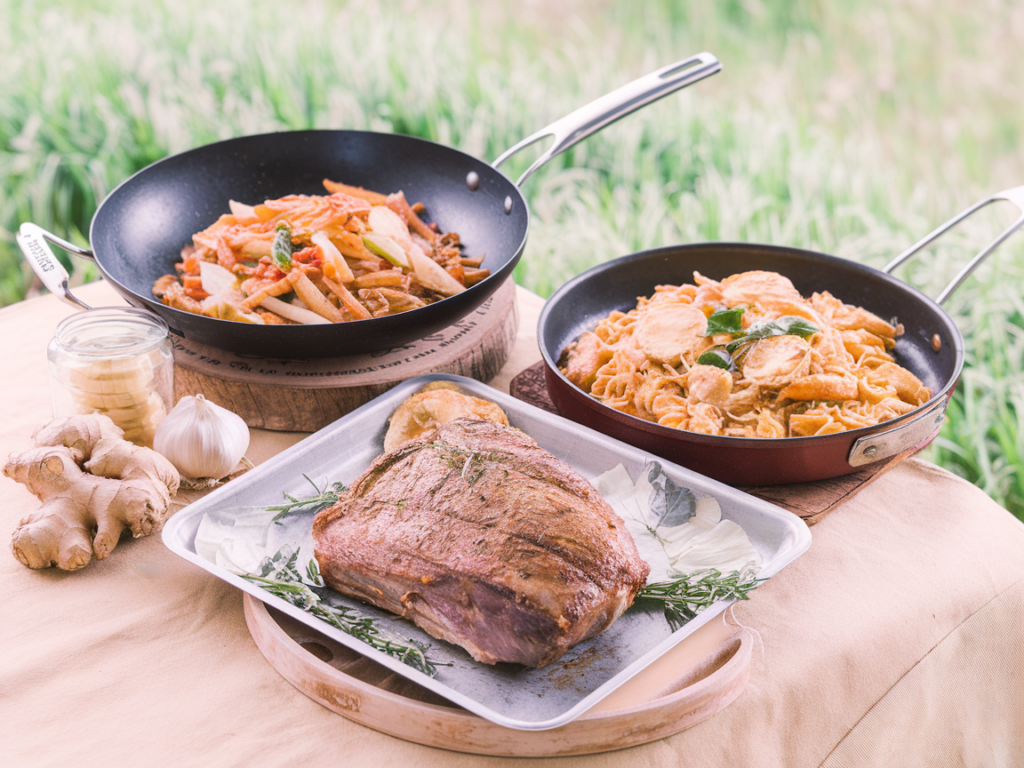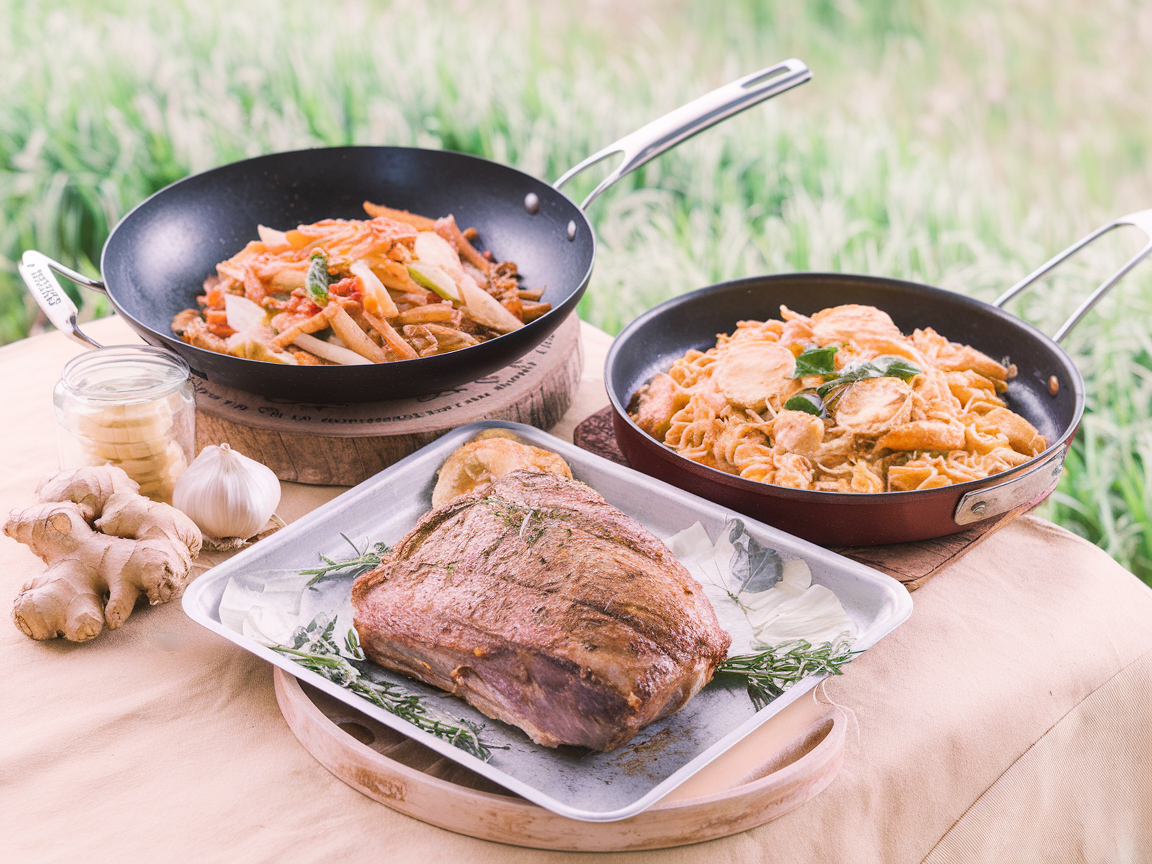Introduction: The Dynamic Duo of Ginger and Garlic
Ginger and garlic have long been cherished as culinary cornerstones and medicinal marvels. From the aromatic sizzle of garlic hitting a hot pan to the zesty zing of ginger infusing a stew, these ingredients are indispensable in kitchens around the world. Their versatility makes them a staple in cuisines spanning Asia, Europe, Africa, and the Americas.
Beyond their bold flavors, ginger and garlic bring a treasure trove of health benefits. Packed with antioxidants, anti-inflammatory properties, and essential nutrients, they elevate dishes and well-being alike. Whether you’re preparing a quick stir-fry, a hearty roast, or a soothing broth, understanding how to use these ingredients effectively is key to creating culinary masterpieces.
In this article, we’ll dive deep into the world of ginger and garlic in recipes. You’ll learn their flavor profiles, preparation techniques, and tips for avoiding common mistakes. Plus, we’ll explore their health benefits, popular recipes, and even substitutes for when you’re in a pinch.
Let’s get started!

Why Ginger and Garlic Are Essential in Cooking
Ginger and garlic hold a revered place in culinary traditions across the globe. Their ability to enhance flavor, enrich nutritional value, and add complexity to dishes makes them staples in nearly every cuisine. But what makes them so irreplaceable? Let’s explore their significance in more detail.
The Cultural and Culinary Importance
Across cultures, ginger and garlic are often referred to as “the flavor backbone” of many dishes. Whether it’s a Chinese stir-fry, Indian curry, or Mediterranean marinade, these ingredients create depth and complexity that’s hard to replicate.
- Ginger adds a spicy warmth and slight sweetness that enhances both sweet and savory dishes.
- Garlic provides a pungent, umami-rich base that amplifies the flavors of other ingredients.
In traditional medicine, both are hailed for their therapeutic properties. Ayurvedic and Traditional Chinese Medicine (TCM) texts often recommend ginger and garlic for their warming effects and healing properties.
Nutritional Benefits of Ginger and Garlic
Both ginger and garlic pack a nutritional punch, offering essential vitamins, minerals, and bioactive compounds:
- Ginger
- Contains gingerol, a powerful antioxidant and anti-inflammatory compound.
- Rich in vitamin C, magnesium, and potassium.
- Promotes digestion and reduces nausea.
- Garlic
- Packed with allicin, a sulfur compound known for its antimicrobial properties.
- High in manganese, selenium, and vitamin B6.
- Supports cardiovascular health and boosts immunity.
By combining these two ingredients, you create a powerhouse blend that’s as healthy as it is flavorful.
Flavor Profiles of Ginger and Garlic
Understanding the flavor profiles of ginger and garlic helps you balance their boldness:
- Ginger’s Zesty Heat
- Fresh ginger delivers a peppery, citrusy punch.
- Its spiciness mellows when cooked, leaving behind a gentle warmth.
- Dried or ground ginger is sweeter and less pungent.
- Garlic’s Bold Umami
- Raw garlic is sharp, almost spicy, with an intense aroma.
- Cooking garlic softens its bite and brings out its natural sweetness.
- Roasting transforms garlic into a nutty, caramelized treat.
When used together, they create a dynamic balance of heat, sweetness, and savory richness.
When to Use Ginger and Garlic
Their versatility means you can use them in:
- Base Aromatics: Add minced ginger and garlic to oil as the first step in building flavor for soups, stews, or curries.
- Marinades: Their enzymatic action helps tenderize proteins while imparting depth.
- Dressings and Sauces: Create zippy salad dressings or bold dipping sauces.
- Infused Beverages: Brew ginger tea with a touch of garlic for a health-boosting tonic.
Popular Recipes Using Ginger and Garlic
Ginger and garlic are culinary chameleons, seamlessly fitting into a variety of dishes, from appetizers to desserts. Their bold flavors and complementary nature make them essential in countless recipes worldwide. Here’s a closer look at how different cuisines use these ingredients to create magic.
Asian Dishes
In Asian cooking, ginger and garlic are foundational, forming the aromatic base of numerous dishes:
- Chinese Stir-Fries
- Classic stir-fries like Beef with Broccoli or Kung Pao Chicken often start with minced garlic and julienned ginger sizzling in oil.
- These ingredients add layers of flavor, balancing the salty soy sauce and tangy rice vinegar.
- Japanese Gyoza (Dumplings)
- The filling for these dumplings often includes finely chopped garlic and grated ginger, giving a zesty kick to the umami-rich pork or vegetable mix.
- Indian Curries
- Ginger and garlic paste is the base for most curries, like Butter Chicken or Lentil Dal.
- Their combined flavors mellow as they cook, creating a rich and aromatic foundation.
- Thai Soups and Sauces
- Soups like Tom Yum and Tom Kha Gai rely on ginger (or galangal) and garlic to add sharp, earthy notes that balance the creamy coconut milk and spicy chilies.
Western Dishes
While ginger is less common in traditional Western recipes, garlic plays a starring role:
- Garlic Butter Roasts
- Roasted chicken or beef coated with a garlic-herb butter becomes golden and flavorful.
- Adding a touch of grated ginger to the butter elevates the dish with a subtle warmth.
- Pasta Sauces
- Garlic is essential in Italian cooking, especially in sauces like Marinara or Aglio e Olio.
- A hint of ginger can add unexpected brightness to creamy Alfredo sauces.
- Garlic Bread with a Twist
- Mixing minced garlic and ginger with butter before spreading it on bread creates a unique fusion flavor.
- Baked Goods
- Ginger is the star in gingerbread cookies, cakes, and muffins. While garlic isn’t used in desserts, ginger alone can create sweet-spicy treats.

Fusion Recipes
Ginger and garlic also shine in innovative fusion dishes, blending flavors from multiple cuisines:
- Ginger-Garlic Tacos: Infuse taco meat with ginger and garlic for a tangy twist.
- Garlic-Ginger BBQ Sauce: Add these ingredients to a classic BBQ sauce for an Asian-inspired flavor.
- Ginger-Garlic Pizza Topping: Incorporate them into the sauce or topping mix for an earthy depth.
Simple Everyday Recipes
- Ginger-Garlic Marinade: Perfect for chicken, fish, or tofu. Combine minced ginger, garlic, soy sauce, honey, and lime juice.
- Healing Ginger-Garlic Soup: A soothing broth made with fresh ginger, garlic, chicken stock, and a touch of turmeric.
- Garlic-Ginger Stir-Fry Sauce: A quick sauce using soy sauce, sesame oil, garlic, ginger, and cornstarch for thickening.
Health Benefits of Cooking with Ginger and Garlic
Cooking with ginger and garlic not only enhances the flavor of your dishes but also delivers numerous health benefits. These two ingredients are packed with bioactive compounds and nutrients that promote well-being and help prevent illness. Let’s explore how ginger and garlic contribute to a healthier lifestyle.
Boosting Immunity
- Ginger
- Rich in gingerol, a compound known for its anti-inflammatory and antioxidant properties.
- Helps ward off infections by improving immune response.
- Studies show that ginger can reduce the risk of respiratory infections and ease symptoms of colds.
- Garlic
- Contains allicin, a sulfur compound that provides powerful antibacterial and antiviral effects.
- Garlic boosts the production of white blood cells, which play a critical role in fighting off viruses and bacteria.
- Regular consumption of garlic is linked to a reduced risk of catching common illnesses like colds and flu.
Tip: For maximum benefits, add freshly grated ginger and crushed garlic to soups and stews during the cooking process.
Supporting Digestive Health
- Ginger is a well-known remedy for digestive issues, including bloating, indigestion, and nausea.
- It stimulates saliva and bile production, aiding digestion.
- Useful for relieving motion sickness and morning sickness during pregnancy.
- Garlic promotes a healthy gut microbiome by acting as a natural prebiotic.
- Its compounds nourish beneficial gut bacteria, improving overall gut health.
Reducing Inflammation and Pain
Chronic inflammation is a root cause of many health issues, including arthritis and heart disease. Ginger and garlic both have potent anti-inflammatory effects:
- Ginger: Reduces muscle soreness and joint pain, thanks to gingerol. It’s especially beneficial for athletes and individuals with arthritis.
- Garlic: Decreases inflammation markers in the body, helping to alleviate symptoms of inflammatory conditions.
Pro Tip: Drink ginger tea with a hint of crushed garlic for a natural anti-inflammatory boost.
Improving Heart Health
Ginger and garlic are heart-friendly ingredients that can reduce the risk of cardiovascular disease:
- Garlic:
- Lowers blood pressure and cholesterol levels, reducing strain on the heart.
- Prevents blood clots, improving circulation and lowering the risk of stroke.
- Ginger:
- Improves blood sugar control and reduces LDL (bad) cholesterol.
- Enhances circulation by relaxing blood vessels.
Supporting Weight Management
Incorporating ginger and garlic into your diet can help with weight control:
- Ginger speeds up metabolism and promotes fat burning. It also suppresses appetite by regulating hormones associated with hunger.
- Garlic boosts energy levels, helping you stay active, while also reducing fat storage by modulating fat-storing enzymes.
Combating Chronic Diseases
- Cancer Prevention
- Garlic’s organosulfur compounds may reduce the risk of certain cancers, including stomach and colorectal cancer.
- Ginger contains antioxidants that protect cells from damage and reduce the risk of chronic diseases.
- Diabetes Management
- Ginger improves insulin sensitivity, helping regulate blood sugar levels.
- Garlic can reduce fasting blood sugar levels, supporting better diabetes management.
Practical Tip for Daily Use
To reap these benefits, include ginger and garlic in your everyday cooking:
- Add them to salad dressings, marinades, or soups.
- Brew a cup of ginger tea with a clove of garlic for a morning health boost.
FAQs About Ginger and Garlic in Recipes
Here are some frequently asked questions about using ginger and garlic in recipes, covering everything from preparation to health benefits.
Q1: Can I use powdered ginger and garlic instead of fresh?
A: Yes, powdered ginger and garlic can be used as substitutes for fresh. However, the flavors will be less intense and aromatic. When using powdered forms, reduce the quantity as they are more concentrated. For example, 1 teaspoon of garlic powder equals about 1 clove of fresh garlic, and 1/4 teaspoon of ground ginger equals 1 teaspoon of fresh ginger.
Q2: How can I make my ginger and garlic paste last longer?
A: To extend the shelf life of ginger-garlic paste:
- Add a teaspoon of oil or vinegar as a natural preservative.
- Store the paste in an airtight container in the fridge for up to a week.
- For longer storage, freeze the paste in ice cube trays and use as needed.
Q3: Can ginger and garlic be eaten raw?
A: Yes, both can be eaten raw and have unique health benefits in their raw state.
- Raw Garlic: Known for its strong antimicrobial properties, raw garlic can boost immunity and heart health.
- Raw Ginger: Helps reduce nausea and inflammation. Grate it into smoothies or chew a small piece for digestive relief.
However, raw garlic has a very sharp taste, so consume it sparingly.
Q4: Why does garlic sometimes turn blue or green when cooked?
A: Garlic can turn blue or green due to a reaction between sulfur compounds in the garlic and certain acids or metals during cooking.
- It’s safe to eat and doesn’t affect the flavor.
- To prevent this, use fresh garlic and avoid cooking it in highly acidic ingredients like vinegar for long periods.
Q5: How do I fix a dish if I’ve added too much garlic or ginger?
A: If the flavor of ginger or garlic is overpowering, try these fixes:
- Dilute the Dish: Add more of the base ingredients (e.g., broth, vegetables, or protein) to balance the flavors.
- Add Sweetness: A small amount of sugar or honey can tone down the sharpness.
- Neutralize the Taste: Use dairy products like yogurt or cream to mellow the intensity.
Q6: What are some quick ways to use ginger and garlic together?
A: Here are a few simple ideas:
- Ginger-Garlic Stir-Fry: Sauté minced ginger and garlic in oil, add vegetables or protein, and season with soy sauce.
- Ginger-Garlic Dressing: Blend them with olive oil, lemon juice, and a dash of honey for a zesty salad dressing.
- Healing Tea: Simmer sliced ginger and crushed garlic in water, add honey, and sip for a soothing drink.
Q7: Can I use ginger and garlic in desserts?
A: While garlic isn’t typically used in desserts, ginger is a versatile ingredient in sweets. You can use it in:
- Gingerbread cookies
- Spiced cakes and muffins
- Ginger-infused syrups for drinks or desserts
Q8: How do I get the garlic smell off my hands after cooking?
A: To remove garlic odor, try:
- Rubbing your hands with stainless steel under running water (like a spoon or sink).
- Washing your hands with lemon juice or a mixture of salt and water.
Q9: Are ginger and garlic safe for children?
A: Yes, both are safe for children in moderate amounts. They can help boost immunity and improve digestion. However, for young children, use them sparingly to avoid overly strong flavors.
Q10: What are good substitutes for ginger and garlic if I don’t have them?
A: If you’re out of ginger or garlic:
- Ginger Substitutes: Galangal, turmeric, or cinnamon (for sweet recipes).
- Garlic Substitutes: Shallots, onion powder, or asafoetida (hing).
Conclusion: The Magic of Ginger and Garlic in the Kitchen
Ginger and garlic are culinary powerhouses that add incredible flavor and health benefits to countless recipes. Their versatility, paired with their nutritional and medicinal properties, makes them indispensable in kitchens worldwide. From savory dishes to soothing teas, ginger and garlic prove time and time again that they are more than just ingredients—they’re the heart of exceptional cooking.

